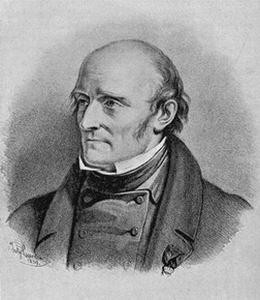|
|
PER HENRIK LING




 Per Henrik Ling (15 November 1776-3 May 1839) was a Swedish medical-gymnastic practitioner. He is widely known in the world of alternative therapies as the originator of Swedish massage, but this is a somewhat limiting view of a man with wide-ranging interests in the human body, and indeed the soul. Per Henrik Ling (15 November 1776-3 May 1839) was a Swedish medical-gymnastic practitioner. He is widely known in the world of alternative therapies as the originator of Swedish massage, but this is a somewhat limiting view of a man with wide-ranging interests in the human body, and indeed the soul.
Ling was born at Ljunga in the south of Sweden in 1776, the son of a minister, Lars Peter Ling, and the former Hedvig Maria (Hedda) Molin. Through his mother, he was a great-great grandson of the famous Swedish scientist Olof Rudbeck (1630-1702), discoverer of the human LYMPHATIC SYSTEM.
As a young man Ling seemed to be destined for a literary career, and wrote romantic poetry and novels. But while travelling abroad, on his first voyage he befriended a certain "Ming", a Chinese fellow who was both a martial artist and 'tui na' practitioner. They soon became fencing and exercise partners in Copenhagen, where Ling studied at the University of Copenhagen and taught modern languages. During the first four years of his voyage Ling had received much guidance by his Chinese friend, specifically on fighting, exercise and health philosophies that fascinated him for their amazing integration and efficiency. His journey then took him to Germany, France and England during which he continued to acquire more knowledge on his friend's special "gymnastics" or exercises designed to improve the strength, flexibility and overall stamina necessary to his fencing passion.
Financial difficulties, joint (overuse) injuries and rheumatism caused him to return to Sweden where he took the time to heal himself by applying these pressing-pulling and squeezing exercises and maneuvers he had learned. In 1804, he obtained a post as fencing master at the University of Lund in southern Sweden. He was fascinated by the human body in movement, and began to make a detailed study of the limb movements of his fencing students. From this, he developed a system of exercises to be used in schools and the Swedish armed forces. Some may remember 'Swedish Drill' from their schooldays, and this method is still in use in some places.
He found that his daily exercises had completely restored his bodily health, and his thoughts now turned towards applying this experience for the benefit of others. He saw the potential for adapting these techniques to promote better health in many situations and thus attended classes on anatomy and physiology, and went through the entire curriculum for the training of a doctor. He then elaborated a system of gymnastics, exercises and maneuvers, divided into four branches, (1) pedagogical, (2) medical, (3) military, (4) aesthetic, which carried out his theories and would demonstrate the required occidental scientific rigor to be integrated or approved by established medical practitioners.
In 1813 he received Royal permission to open in Stockholm the 'Central Institute for Gymnastics' (still in existence) for the education of future professionals in 'Sjukgymnastik' that is, naturopathy and what Ling termed 'movement cure'. This was the name he gave to his system of massage designed to create movement within the body - the different systems, muscles and joints.
This form of massage is still known in Sweden as 'Lingism' and is still taught in the Institute that he founded. It was only when it began to be known in other countries that the term 'Swedish Massage' was used to designate Ling's original method. Unfortunately, in the process, the sensitive and serious approach which Ling advocated was discarded, and much of what is now known as Swedish Massage is far from what was envisaged by this poet-masseur.
Ling died in 1839, having previously named as the repositories of his teaching his pupils Lars Gabriel Branting (1799-1881), who succeeded him as principal of the Institute, and August Georgii, who became sub-director; his son, Hjalmar Ling (1820-1886), being for many years associated with them. All these, together with Major Thure Brandt, who from about 1861 specialized in the treatment of women (gynecological gymnastics), are regarded as the pioneers of Swedish medical gymnastics.
Ling and his earlier assistants left no proper written account of their treatment, and most of the literature on the subject is repudiated by one set or other of the gymnastics practitioners. The origins and greatest influences of Dr Ling's work was certainly those of his Chinese friend "Ming" who had introduced him to Tuina and martial arts. The loss of filiation with these oriental influences were uncovered inadvertently by Johan Georg Mezger (1838-1909) who coined a reduced set of maneuvers and techniques of Dr. Ling's system as the "Swedish massage" system. These techniques were effleurage (long, gliding strokes), petrissage (lifting and kneading the muscles), friction (firm, deep, circular rubbing movements), tapotement (brisk tapping or percussive movements), and vibration (rapidly shaking or vibrating specific muscles). These are also the basic techniques of tui na and Chinese massage.
Back to the top of the page


|
|
|